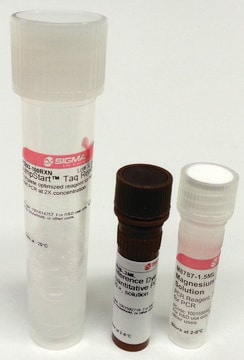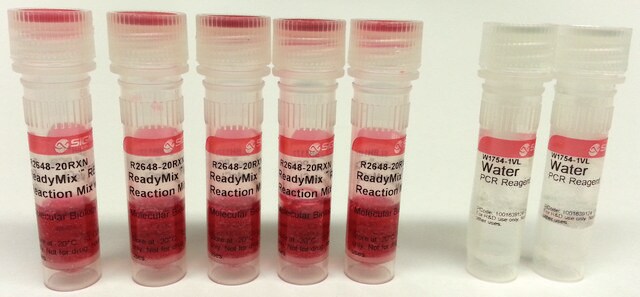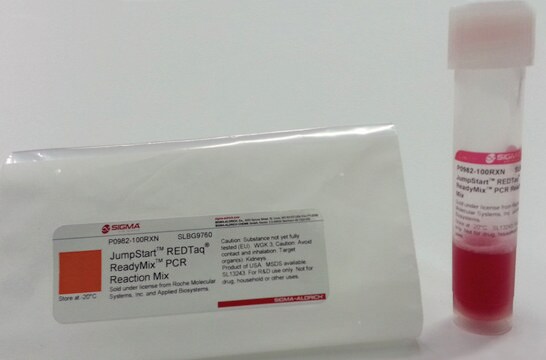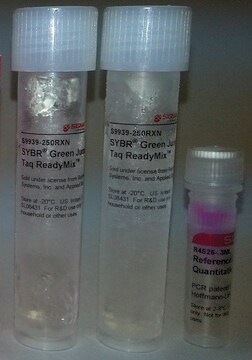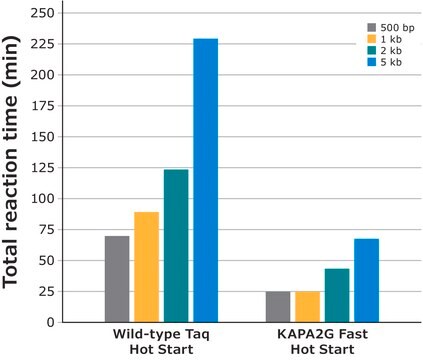P2893
JumpStart™ Taq ReadyMix™
Complete optimized reagent for hot-start PCR at 2X concentration
Synonym(s):
hot start PCR master mix, hot start master mix, hot start taq master mix, mutiplex PCR
About This Item
Recommended Products
Quality Level
form
liquid
usage
sufficient for 100 reactions
sufficient for 400 reactions
feature
Multiplex PCR
dNTPs included
hotstart
concentration
2.5 units/reaction (50 μL reaction volume)
technique(s)
PCR: suitable
color
colorless
suitability
suitable for (quantitative PCR)
application(s)
agriculture
shipped in
wet ice
storage temp.
−20°C
General description
Application
- For PCR amplifications that require reduced non-specific amplification
- For multiplex PCR
- For reduction of primer dimers
Features and Benefits
- The master mix allows consistency from one reaction to the next
- Reduced preparation time and reduced risk of contamination from multiple pipetting steps
- Designed to minimize non-specific amplification and contamination
- Increased specificity and target yield
- Reduced primer dimers
- Reduced set-up time as compared to manual or wax Hot Start methods
- Allows for room temperature set-up
- Ideal for high throughput, quantitative PCR applications
Packaging
100RXN is packaged as 1 X 2.5 mL
400RXN is packaged as 1 X 10 mL
Other Notes
This product has been validated in quantitative PCR, but may require supplementation with magnesium chloride solution, 25 mM, Catalog Number M8787, a suitable fluorescent probe, and, if desired, an internal reference dye, Catalog Number R4526. View more detailed information on JumpStart Taq ReadyMix products at www.sigma-aldrich.com/hotstart.
Legal Information
related product
Storage Class Code
10 - Combustible liquids
WGK
WGK 2
Flash Point(F)
Not applicable
Flash Point(C)
Not applicable
Certificates of Analysis (COA)
Search for Certificates of Analysis (COA) by entering the products Lot/Batch Number. Lot and Batch Numbers can be found on a product’s label following the words ‘Lot’ or ‘Batch’.
Already Own This Product?
Find documentation for the products that you have recently purchased in the Document Library.
Customers Also Viewed
Articles
Method outlines use of a hot start Taq for multiplex qPCR and provides guidance on how to optimize dNTPs, primer, probes and MgCL2 concentrations. By optimizing these parameters, the user can improve assay sensitivity and linear range of detection.
Learn about the history of the polymerase chain reaction (PCR), from the basic principles that proceeded its discovery to the awarding of a Nobel Prize for Chemistry and more recent developments such as real-time PCR (qPCR) and digital PCR.
Real-time polymerase chain reaction allows researchers to estimate the quantity of starting material in a sample. It has a much wider dynamic range of analysis than conventional PCR
The purpose of Hot Start PCR is to inhibit the PCR reaction in order to reduce nonspecific amplification, prevent the formation of primer dimers, and increase product yields.
Protocols
The CRISPR (Clustered Regularly Interspaced Short Palindromic Repeats) system was discovered in bacteria, where it functions as an adaptive immune system against invading viral and plasmid DNA.
Protocol using antibody mediated hot start polymerase. Method has short activation period (<1min), and results in higher yields and more specificity over standard PCR methods.
When using hot start Taq DNA polymerase, the enzyme remains inactive until heated. Hot Start DNA polymerase control is achieved by chemical or antibody modification of the enzyme.
Our team of scientists has experience in all areas of research including Life Science, Material Science, Chemical Synthesis, Chromatography, Analytical and many others.
Contact Technical Service